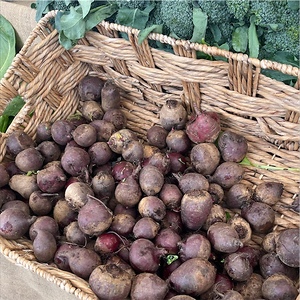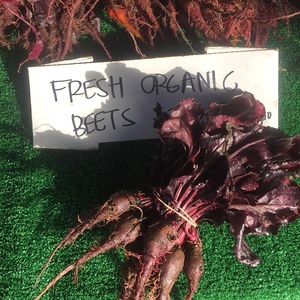


Baby Bulls Blood Beets
Estimated Inventory, bunch : 0
Description/Taste
Baby Bull's Blood beets are an heirloom variety bearing red roots, stems, and leaves. The roots average 7-10 centimeters in diameter and have a globular, flattened shape with one small, pointed end. The skin of the root is semi-rough, dark red, firm, and covered in root hairs. Connecting to the roots, the thick stems are crisp, fibrous, and crimson, and the glossy leaves have a blend of maroon and green hues with prominent veining. Underneath the thin skin, the flesh is dense, aqueous, and dark burgundy. Baby Bull’s Blood beets have an earthy, sweet, and nutty flavor.
Seasons/Availability
Baby Bull's Blood beets are available year-round.
Current Facts
Baby Bull’s Blood beets, botanically classified as Beta vulgaris, are the roots of an herbaceous plant that grows leafy stalks up to thirty-three centimeters in height and belongs to the Amaranthaceae family. Considered a rare, heirloom variety, Baby Bull’s Blood beets were initially grown for their dark red, tender leaves and their roots were harvested as a secondary crop. In modern day the roots have surpassed the greens in popularity, but it is necessary to harvest the beets in a young state as the larger beets are considered unfit for culinary use. Most commercial growers cultivate Baby Bull's Blood beets as a specialty variety, and both the root and leaves are utilized in culinary applications.
Nutritional Value
Baby Bull’s Blood beets contain potassium, fiber, vitamin A, folic acid, and calcium.
Applications
Baby Bull’s Blood beets can be used raw, shredded or sliced in salads, or they can be steamed, roasted, boiled, or fried. The roots are used interchangeably with common red beets in recipes and are popularly roasted to develop a caramelized exterior with a soft, tender interior. Baby Bull’s Blood beets can also be used in soups, sliced into chips and fried, or cubed and mixed into hearty grain bowls. In addition to cooked applications, the roots can be juiced or pickled for extended use. Baby Bull’s Blood beets pair well with bacon, prosciutto, smoked fish, eggs, shallots, garlic, dill, chives, paprika, walnuts, hazelnut, citrus, and vinegar. The roots will keep up to two weeks with the leaves removed when stored in the crisper drawer of the refrigerator and up to one week when stored with the tops still attached.
Ethnic/Cultural Info
In Europe and the United States, Baby Bull’s Blood beets are a popular home garden variety planted for their dark red, showy leaves. The plant’s dark hues provide a dynamic contrast to predominately green gardens, allowing gardeners to showcase their artistic expression via plants, and gardeners value that both the leaves and roots are edible. Baby Bull’s Blood beets are also favored as a natural food dye. In the United States, the beets are used to dye cakes and muffins and are used as a substitute ingredient to make dessert recipes lighter and healthier. The roots are also used to make the only red food coloring allowed by law in Sweden.
Geography/History
Bull's blood beets were developed in the 1840s by Kees Sahin in the Netherlands. Believed to have been created from the crapaudine, which is a French heirloom variety that is considered to be the oldest beet still in existence, bull's blood beets were initially developed for their foliage, and the use of the roots did not occur until many years later. Today Baby Bull’s Blood beets can be found in home gardens and through specialty grocers and farmers markets in Asia, Europe, and North America.
Recipe Ideas
Recipes that include Baby Bulls Blood Beets. One
Podcasts













